Categories
Archives
Yesterday Michael Steidl, Lead of the IPTC Photo Metadata Working Group, gave a webinar to Bundesverband professioneller Bildanbieter (BVPA), the Federal Association of Professional Image Providers in Germany.

The webinar focused on the recently introduced image license information for Google image searches and the possible opportunities and risks for the professional image business.
“This year, Google introduced the so-called Licensable Badge for its image search. This feature enables images to be linked to license information and to be displayed in the image search results with a corresponding link. Image seekers from advertising, editorial offices and corporate PR can follow the link to obtain further information on how to use the image. This turns Google image search into a potential marketplace. But how can image providers use the new tool for themselves? Is it worth the effort of storing the necessary metadata? Are there any economic risks involved? Will Google soon become a meta picture agency?”
In the first part of the webinar, Michael Steidl explained which image metadata must be stored in order to display photo credits and “licensable” badges on Google. He also informed participants about the problem that certain software and web platforms deletes image metadata after upload.
In the second part, Alexander Karst explains the possibilities for increasing visibility through the new features and gives an assessment of the effects on the image market.
Thanks to BVPA for hosting Michael for the webinar.
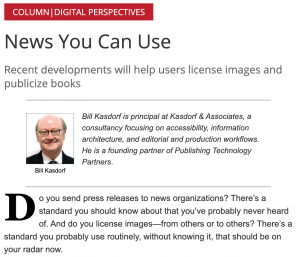 Bill Kasdorf, principal at Kasdorf & Associates and individual member of IPTC, has published his latest column at Publishers Weekly, “News You Can Use”, where he promotes IPTC standards including IPTC Photo Metadata and IPTC Media Topics.
Bill Kasdorf, principal at Kasdorf & Associates and individual member of IPTC, has published his latest column at Publishers Weekly, “News You Can Use”, where he promotes IPTC standards including IPTC Photo Metadata and IPTC Media Topics.
As Bill says, “I recently attended the IPTC Autumn Meeting, and at virtually every session, I thought, “People in other sectors of publishing ought to know about what the IPTC has to offer them.”
Bill goes on to discuss IPTC’s work with Google on exposing IPTC Photo Metadata in Google search results and the Licensable Images feature in Google Images search, explaining how those in the publishing industry can use those features to find out who owns the copyright on an image they might want to re-use, and how to obtain a license to use it.
He also talks about IPTC’s Media Topics subject taxonomy, and how publishers could use it for press releases, so they can “be sure the terms you use are the ones the news industry itself uses”.
You can view the article on the Publisher’s Weekly website.
Thanks Bill for sharing your thoughts and for promoting the IPTC cause!
IPTC Managing Director Brendan Quinn spoke at the FIBEP World Media Intelligence Congress 2020 on Wednesday 18th November.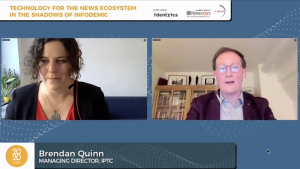
FIBEP is the industry body for the “media intelligence” industry, including media monitoring, public relations and marketing organisations.
FIBEP was founded over 65 years ago (so it is even older than IPTC!) and the FIBEP World Media Intelligence Congress has become one of the largest events for communications, public relations, technology, social media monitoring and marketing professionals alike. It brings together communications professionals from around the world to share best practices, discuss industry developments and innovations, present the latest technology and network through a variety of presentations and panel discussions from industry leaders. So it is in many ways similar to IPTC for the technical side of the news industry.
This year’s theme was Exploring and Expanding the Media Intelligence World and the program included a wide range of best practices and topics relevant for media intelligence and communication professionals including social media monitoring, privacy, and data integrity, copyright, the evolution of data consumption, measurement, PR trends, technological developments and future outlooks for communications and media intelligence industries.
Brendan was invited to speak about IPTC’s view of the news ecosystem, particularly with a view to online misinformation and disinformation and how the news industry can work together to combat those problems. Brendan discussed IPTC’s work on trust and credibility, including the content of the recent IPTC webinar on Trust and Credibility.
Questions from the media intelligence community included what individuals could do to avoid misinformation and spreading false news on social media. Brendan’s advice to those who want to learn more about misinformation are in the table:
Educate your teams to “think before you share” on social media |
|
Reuters has put together a course on “manipulated media” including “deep fake” videos: https://www.reuters.com/manipulatedmedia The EU has created a “Think before you share” campaign: https://euvsdisinfo.eu/think-before-you-share/ |
Stay in touch with fact checking organisations |
| Fact checking organisations such as FullFact, PolitiFact, FactCheck.org and Snopes often release information about topics that are often the subject of disinformation and misinformation such as vaccines, elections and conspiracy theories. Many local organisations can be found via the International Fact-Checking Network. |
Thanks very much to FIBEP, especially Romina Gersuni, for inviting us to present. We realised during the preparations for the event that IPTC and FIBEP have a lot in common, so hopefully this will be the first of many collaborations between the two organisations!
 It is with great sadness that we report that Andrew Read passed away suddenly on Sunday 8 November, 2020.
It is with great sadness that we report that Andrew Read passed away suddenly on Sunday 8 November, 2020.
Andy was a passionate member of the IPTC for over 20 years, first through Reuters, then Thomson Reuters and most recently as the BBC’s main representative at the IPTC.
Andy contributed to NewsML-G2 and the IPTC News Architecture, RightsML and other rights-related work, and followed our other work including Photo Metadata and our sports standards. A frequent attendee and speaker at our face-to-face IPTC member meetings, Andy also helped to organise IPTC’s London meetings, including the special Rights Day in 2013 and Rights Management in News day in 2017.
A committed believer in the benefit of industry organisations, he also contributed to the EBU’s metadata activities and organised collaborations with the DPP. Just a few weeks ago at the IPTC Autumn 2020 Meeting, Andy presented his most recent project at the BBC, an adaptation of the Guardian’s open-source digital asset management system for use as the BBC’s main image asset library. He was always making connections between IPTC members and outside organisations, research projects and startups, and loved bringing people together to discuss what technology can bring to the media industry.
Andy will be fondly remembered by all of his IPTC colleagues for his friendly, supportive manner and willingness to help anyone with anything.
When IPTC members get together it often feels like a family reunion, and Andy has been a key part of the IPTC family for the past 20 years. He will be sorely missed.
UPDATE: If you would like to share your memories of Andy or make a donation to his preferred charity, please see the tribute site: https://andyread.muchloved.com/
The Digital Media Licensing Association (DMLA) is holding its annual conference this week. IPTC and IPTC members have a strong presence – particularly IPTC’s Video Metadata Hub.

Mark Milstein of IPTC member Microstocksolutions joined in hosting the opening “virtual cocktail party” on Sunday 25 October. Mark is leading efforts to promote IPTC’s Video Metadata Hub at DMLA, see his recent post on DMLA’s site.
Angela Weiss, a staff photographer with IPTC member Agence France-Presse, took part in a panel “Tales from the Trenches – True Stories from Working Photojournalists” on Monday. Then Mark Milstein was back on the “Hot Topics in Tech” panel along with Matthew O’Such of IPTC member Getty Images. Matthew also spoke on our panel at the IPTC Photo Metadata Conference two weeks ago.
On Tuesday, Andy Parsons of IPTC member Adobe is presenting a keynote on the Content Authenticity Initiative. Of course IPTC members already heard Andy speak at the Photo Metadata Conference, and at the Adobe MAX conference last week. Andy is very busy getting the word out!
On Wednesday, Mathieu Desoubeaux of new IPTC member IMATAG speaks on the “Image Protection – Creating a More Secure Ecosystem” panel.
On Thursday, Matthew O’Such of Getty Images is back along with Francois Spies of Google giving a reprise of his IPTC Photo Metadata Conference talk on the Google search “Licensable Images” features. Also on the panel is Roxana Stingu of Alamy, part of IPTC member PA Media.
Thursday afternoon, IPTC metadata gets a front-row seat at DMLA with the “Taming Video Metadata” panel, moderated by Mark Milstein of Microstocksolutions and featuring a presentation by Pam Fisher, IPTC individual member and lead of the IPTC Video Metadata Working Group. On the panel, Zach Bernstein of Storyblocks will be speaking about his implementation of IPTC’s Video Metadata Hub.
The conference also features panels on synthetic content, the legal aspects of the photo licensing industry, artificial intelligence and more.
Thanks to DMLA for putting together such an interesting event!
 In association with World News Day, IPTC is presenting a webinar on our efforts to help news organisations address trust, credibility and misinformation via our standards.
In association with World News Day, IPTC is presenting a webinar on our efforts to help news organisations address trust, credibility and misinformation via our standards.
Through our work with The Trust Project, Reporters Sans Frontières’ Journalism Trust Initiative, Credibility Coalition and others, we have been able to create extensions to IPTC standards to enable news organisations to express various “Trust Indicators”.
Learn more about how this works and how it can lead to a more trustworthy news media.
Register for the webinar here via Zoom
UPDATE: The webinar has now ended, but you can view the recording by registering on the link above.
For information on other World News Day events, please see the main site at https://worldnewsday.org/
 Michael Steidl, Lead of the IPTC Photo Metadata Working Group, spoke on a workshop panel at the Perpignan Photojournalism Conference “Visa Pour L’Image”.
Michael Steidl, Lead of the IPTC Photo Metadata Working Group, spoke on a workshop panel at the Perpignan Photojournalism Conference “Visa Pour L’Image”.
The panel session was pre-recorded and released this week.
This joint workshop from Google, IPTC and Alamy covers some product updates from Google Images, including Image Rights Metadata and the new features on Google Images highlighting licensing information for images that we announced earlier this week. The speakers share best practices and experience on these features.
The speakers are:
- John Mueller, Google Senior Webmaster Trends Analyst
- Michael Steidl, IPTC working group lead
- Roxana Stingu, Alamy SEO Head
The IPTC is very happy to announce that as a result of our collaboration with Google and CEPIC, Google Images’s new licensable badge and other related features are now live.
This means that when photo owners include a photograph’s Web Statement of Rights (also known as Copyright Info URL) in an image’s embedded metadata, Google will display a “Licensable” badge on the image in Google Images search results and the image will appear when the “View all images with Commercial or other licenses” filter is selected. If the Licensor URL is also added, Google will feature a “get this image on” link that takes users directly to a page on the photo owner’s site enabling the user to easily obtain a license to re-use the image elsewhere.
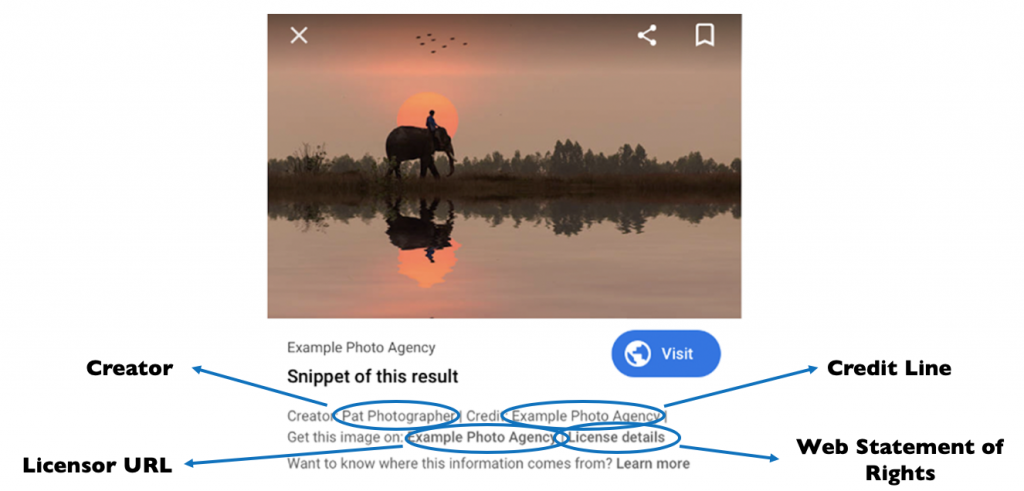
The launch on Google Images comprises three different components:
- “Licensable” badge on image search results for images that have the required metadata fields
- Two new links in the Image Viewer (the panel that appears when a user selects an image result) for people to access the image supplier’s licensing information, namely:
- A “License details” link. This directs users to a page defined by the image supplier explaining how they can license and use the image responsibly
- A “Get this image on” link, which directs users to a page from the image supplier where users can directly take the necessary steps to license the image
- A “License details” link. This directs users to a page defined by the image supplier explaining how they can license and use the image responsibly
- A Usage Rights drop-down filter in Google Image search results pages to support filtering results for Creative Commons, commercial, and other licenses.
“As a result of a multi-year collaboration between IPTC and Google, when an image containing embedded IPTC Photo Metadata is re-used on a popular website, Google Images will now direct interested users back to the supplier of the image,” said Michael Steidl, Lead of the IPTC Photo Metadata Working Group. “This is a huge benefit for image suppliers and an incentive to add IPTC metadata to image files.”
The features have been in beta since February, and after extensive testing, refinement and discussion with IPTC, CEPIC and others, Google is rolling out the new features this week.
As we describe in the Quick guide to IPTC Photo Metadata and Google Images, image owners can choose from two methods to enable the Licensable badge and “Get this image” link: embedding IPTC metadata in image files, or including structured schema.org metadata in the HTML of the web page hosting the image.
Of the two approaches, using embedded IPTC metadata has two benefits. Firstly, the embedded metadata stays with the image even when it is re-used, so that the Licensable badge will appear even when the image is re-published on another website.
Secondly, the “Creator”, “Copyright” and “Credit” messages are only displayed in search results when they are declared using embedded IPTC metadata.
“The IPTC anticipates that this will lead to increased awareness of image ownership, copyright and licensing issues amongst content creators and users,” said Brendan Quinn, Managing Director of IPTC. “By providing direct leads to image owners’ websites, we hope that this leads to increased business for image suppliers both large and small.”
The Google announcements can be found here:
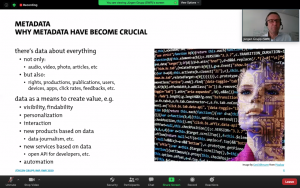 On July 1st 2020, IPTC was invited to participate in an online workshop held by the Arab States Broadcasting Union (ASBU).
On July 1st 2020, IPTC was invited to participate in an online workshop held by the Arab States Broadcasting Union (ASBU).
In a joint presentation, Brendan Quinn (IPTC Managing Director) and Robert Schmidt-Nia (Chair of IPTC and consultant with DATAGROUP Consulting Services) spoke on behalf of IPTC and Jürgen Grupp (data architect with the German public broadcaster SWR) spoke on behalf of the European Broadcasting Union.
The invitation was extended to IPTC and EBU because ASBU is looking at creating a common framework for sharing content between ASBU member broadcasters.
Jürgen Grupp started with an overview of why metadata is important in broadcasting and media organisations, and introduced the EBU’s high-level architecture for media, the EBU Class Conceptual Data Model (CCDM). and the EBUCore metadata set. Jürgen then gave examples of how CCDM and EBUCore are implemented by some European broadcasters.
Next, Brendan Quinn introduced IPTC and the IPTC News Architecture, the underlying logical model behind all of IPTC’s standards. We then took a deep dive into some video-related NewsML-G2 constructs like partMeta (used to describe metadata for parts of a video such as the rights and descriptive metadata for multiple time-based shots within a single video file) and contentSet (used to link to multiple renditions of the same video in different formats, resolutions or quality levels).
Then Robert Schmidt-Nia described some real-world examples of implementation of NewsML-G2 and the IPTC News Architecture at broadcasters and news agencies in Europe, in particular touching on the real-world issues of whether to “push” content or to create a “content API” that customers can use to select and download the content that they would like.
A common theme throughout our presentations was that the representation of the data in XML, RDF, JSON or some other format is relatively easy to change, but the important decision is what logical model to use and how to agree on the meaning (semantics) of terms and vocabularies.
A robust question and answer period touched on wide-ranging issues from the choices between XML, RDF and JSON, extending standardised models and vocabularies, and what decisions should be made to decide how to proceed.
This was one of the first meetings of ASBU on this topic and we look forward to assisting them further on their journey to metadata-based content sharing between their members.
Previously, we shared that Google was making image credits and usage rights information more visible on Google Images. Google now displays information about image copyright and ownership details, alongside creator and credit info, when websites and photo-owners make that information available for Google to crawl. Since the announcement there has been steady growth in the amount images containing these embedded metadata fields, which in turn has helped drive greater user awareness of copyright for images on the internet.
Up to now, users have seen the IPTC metadata information when they click on the “Image Credits” link in the “Google Images viewer” – the panel that appears when a user selects an image. Starting from today, users will begin to see this information directly in the viewer, making this rights-related information even more visible.
You can see an example of what this looks like below:
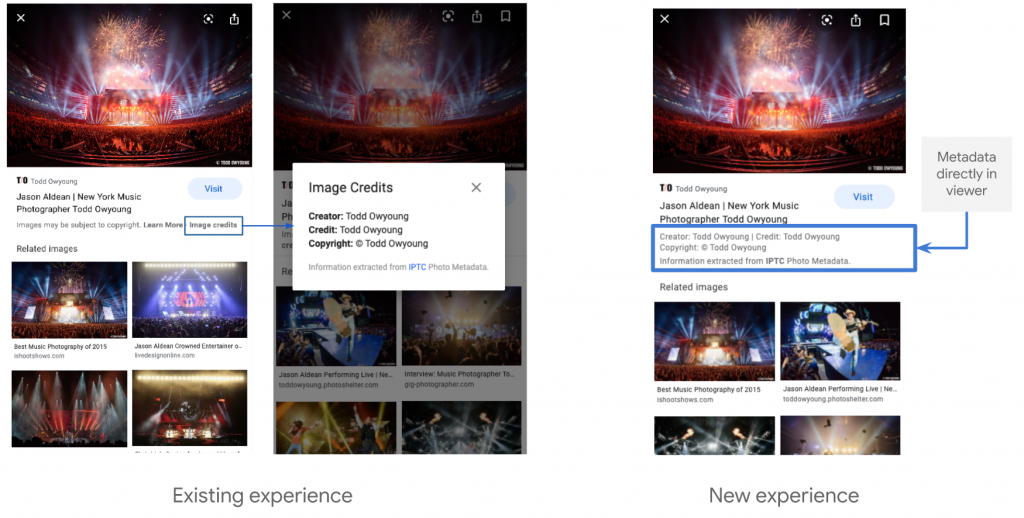
The Google Images team has said in a statement: “We are committed to helping people understand the nature of the content they’re looking at on Google Images. This effort to make IPTC-related information more visible is one more step in that direction.”
For more information on how you can embed rights and credits metadata in your photos, please see our Quick Guide to IPTC Photo Metadata and Google Images.
If you create photo editing or manipulation software and are looking for more information, please consult the Quick Guide or contact us for more information and advice.
We are very happy to continue working with Google and our partner organisation CEPIC on this and other developments in this area. We look forward to making an announcement about the launch of the related “Licensable Images” feature over the summer.
Categories
Archives
- December 2025
- November 2025
- October 2025
- September 2025
- August 2025
- July 2025
- June 2025
- May 2025
- April 2025
- March 2025
- February 2025
- January 2025
- December 2024
- November 2024
- October 2024
- September 2024
- August 2024
- July 2024
- June 2024
- May 2024
- April 2024
- March 2024
- February 2024
- December 2023
- November 2023
- October 2023
- September 2023
- August 2023
- July 2023
- June 2023
- May 2023
- March 2023
- February 2023
- January 2023
- December 2022
- November 2022
- October 2022
- September 2022
- August 2022
- July 2022
- June 2022
- May 2022
- April 2022
- March 2022
- February 2022
- January 2022
- December 2021
- November 2021
- October 2021
- September 2021
- August 2021
- July 2021
- June 2021
- May 2021
- April 2021
- February 2021
- December 2020
- November 2020
- October 2020
- September 2020
- August 2020
- July 2020
- June 2020
- May 2020
- April 2020
- March 2020
- February 2020
- December 2019
- November 2019
- October 2019
- September 2019
- July 2019
- June 2019
- May 2019
- April 2019
- February 2019
- November 2018
- October 2018
- September 2018
- August 2018
- July 2018
- June 2018
- May 2018
- April 2018
- March 2018
- January 2018
- November 2017
- October 2017
- September 2017
- August 2017
- June 2017
- May 2017
- April 2017
- December 2016
- November 2016
- October 2016
- September 2016
- August 2016
- July 2016
- June 2016
- May 2016
- April 2016
- February 2016
- January 2016
- December 2015
- November 2015
- October 2015
- September 2015
- June 2015
- April 2015
- March 2015
- February 2015
- November 2014